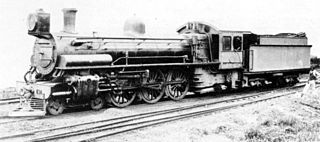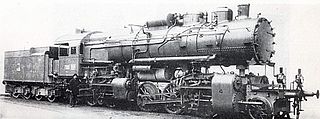
A steam locomotive is a locomotive that provides the force to move itself and other vehicles by means of the expansion of steam. It is fuelled by burning combustible material to heat water in the locomotive's boiler to the point where it becomes gaseous and its volume increases 1,700 times. Functionally, it is a steam engine on wheels.
A chimney is an architectural ventilation structure made of masonry, clay or metal that isolates hot toxic exhaust gases or smoke produced by a boiler, stove, furnace, incinerator, or fireplace from human living areas. Chimneys are typically vertical, or as near as possible to vertical, to ensure that the gases flow smoothly, drawing air into the combustion in what is known as the stack, or chimney effect. The space inside a chimney is called the flue. Chimneys are adjacent to large industrial refineries, fossil fuel combustion facilities or part of buildings, steam locomotives and ships.

Main components found on a typical steam locomotive include:

A fire-tube boiler is a type of boiler invented in 1828 by Mark Seguin, in which hot gases pass from a fire through one or more tubes running through a sealed container of water. The heat of the gases is transferred through the walls of the tubes by thermal conduction, heating the water and ultimately creating steam.

The LSWR N15 class was a British 2–cylinder 4-6-0 express passenger steam locomotive designed by Robert Urie. The class has a complex build history spanning three sub-classes and ten years of construction from 1918 to 1927. The first batch of the class was constructed for the London and South Western Railway (LSWR), where they hauled heavy express passenger trains to the south coast ports and further west to Exeter. After the Lord Nelsons, they were the second biggest 4-6-0 passenger locomotives on the Southern Railway. They could reach speeds of up to 90 mph (145 km/h).

A funnel is the smokestack or chimney on a ship used to expel boiler steam and smoke or engine exhaust. They are also commonly referred to as stacks.

A smokebox is one of the major basic parts of a steam locomotive exhaust system. Smoke and hot gases pass from the firebox through tubes where they pass heat to the surrounding water in the boiler. The smoke then enters the smokebox, and is exhausted to the atmosphere through the chimney. Early locomotives had no smokebox and relied on a long chimney to provide natural draught for the fire but smokeboxes were soon included in the design for two specific reasons. Firstly and most importantly, the blast of exhaust steam from the cylinders, when directed upwards through an airtight smokebox with an appropriate design of exhaust nozzle, effectively draws hot gases through the boiler tubes and flues and, consequently, fresh combustion air into the firebox. Secondly, the smokebox provides a convenient collection point for ash and cinders ("char") drawn through the boiler tubes, which can be easily cleaned out at the end of a working day. Without a smokebox, all char must pass up the chimney or it will collect in the tubes and flues themselves, gradually blocking them.

A condensing steam locomotive is a type of locomotive designed to recover exhaust steam, either in order to improve range between taking on boiler water, or to reduce emission of steam inside enclosed spaces. The apparatus takes the exhaust steam that would normally be used to produce a draft for the firebox, and routes it through a heat exchanger, into the boiler water tanks. Installations vary depending on the purpose, design and the type of locomotive to which it is fitted. It differs from the usual closed cycle condensing steam engine, in that the function of the condenser is primarily either to recover water, or to avoid excessive emissions to the atmosphere, rather than maintaining a vacuum to improve both efficiency and power.

The LNER W1 No. 10000 was an experimental steam locomotive fitted with a high pressure water-tube boiler. Nigel Gresley was impressed by the results of using high-pressure steam in marine applications and so in 1924 he approached Harold Yarrow of shipyard and boilermakers Yarrow & Company of Glasgow to design a suitable boiler for a railway locomotive, based on Yarrow's design.

The A2 class was an express passenger locomotive that ran on Victorian Railways from 1907 to 1963. A highly successful design entirely the work of Victorian Railways' own design office, its long service life was repeatedly extended as the Great Depression and later World War II delayed the introduction of more modern and powerful replacement locomotives.

The Franco–Crosti boiler is a type of boiler used for steam locomotives. It was designed in the 1930s by Attilio Franco and Dr Piero Crosti. The main difference between it and conventional feedwater heaters widely used on the continent is that the Franco-Crosti boiler uses both exhaust steam and exhaust gases from the firebox. Conventional feedwater heaters only use exhaust steam.

A snifting valve is an automatic anti-vacuum valve used in a steam locomotive when coasting. The word Snift imitates the sound made by the valve.

A shell or flued boiler is an early and relatively simple form of boiler used to make steam, usually for the purpose of driving a steam engine. The design marked a transitional stage in boiler development, between the early haystack boilers and the later multi-tube fire-tube boilers. A flued boiler is characterized by a large cylindrical boiler shell forming a tank of water, traversed by one or more large flues containing the furnace. These boilers appeared around the start of the 19th century and some forms remain in service today. Although mostly used for static steam plants, some were used in early steam vehicles, railway locomotives and ships.

The chimney is the part of a steam locomotive through which smoke leaves the boiler. As well, steam locomotive exhaust systems typically vent cylinder steam exhaust through the chimney, to enhance the draught through the boiler. Chimneys are designed to carry the exhaust steam and smoke clear of the driver's line of sight while remaining short enough to clear overhead structures. Some chimneys included apparatus to suppress the dispersal of sparks.

The South African Railways Class 25 4-8-4 of 1953 was a condensing steam locomotive.

The South African Railways Class 10B 4-6-2 of 1910 was a steam locomotive from the pre-Union era in Transvaal.

The Alfred County Railway Class NG G16A 2-6-2+2-6-2 of 1989 is a steam locomotive from the South African Railways era.

The Cape Government Railways Fairlie 0-6-0+0-6-0 of 1876 was a South African steam locomotive from the pre-Union era in the Cape of Good Hope.

The MÁV class 601 was a class of Hungarian four-cylinder Mallet locomotives, which was designed to haul long and very heavy cargo on very steep railway tracks. At 22.5 m long and outputting 2,200 kW (3,000 hp), they were the largest and most powerful steam locomotives built in Europe before and during World War I.

A double chimney is a form of chimney for a steam locomotive, where the conventional single opening is duplicated, together with the blastpipe beneath it. Although the internal openings form two circles, the outside appearance usually forms a single elongated oval.



















